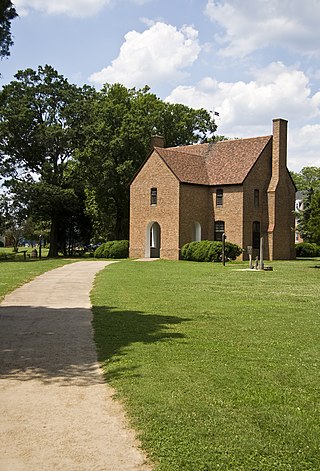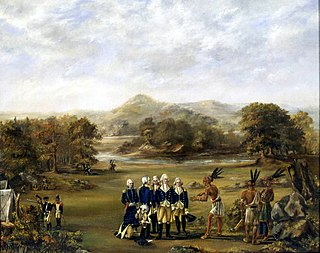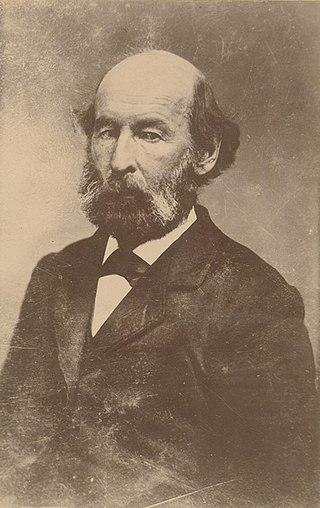
The Oregon Trail was a 2,170-mile (3,490 km) east–west, large-wheeled wagon route and emigrant trail in the United States that connected the Missouri River to valleys in Oregon Territory. The eastern part of the Oregon Trail spanned part of what is now the state of Kansas and nearly all of what are now the states of Nebraska and Wyoming. The western half of the trail spanned most of the current states of Idaho and Oregon.

Iowa is a town in Calcasieu Parish, Louisiana, United States. The population was 3,436 in 2020. It is part of the Lake Charles metropolitan statistical area.

Vinton is a town in Calcasieu Parish, Louisiana, United States. The population was 3,400 in 2020. It is part of the Lake Charles metropolitan statistical area.

The Red River Colony, also known as Assiniboia, was a colonization project set up in 1811 by Thomas Douglas, 5th Earl of Selkirk, on 300,000 square kilometres (120,000 sq mi) of land in British North America. This land was granted to Douglas by the Hudson's Bay Company in the Selkirk Concession. It included portions of Rupert's Land, or the watershed of Hudson Bay, bounded on the north by the line of 52° N latitude roughly from the Assiniboine River east to Lake Winnipegosis. It then formed a line of 52° 30′ N latitude from Lake Winnipegosis to Lake Winnipeg, and by the Winnipeg River, Lake of the Woods and Rainy River.

The New Zealand Company, chartered in the United Kingdom, was a company that existed in the first half of the 19th century on a business model that was focused on the systematic colonisation of New Zealand. The company was formed to carry out the principles devised by Edward Gibbon Wakefield, who envisaged the creation of a new-model English society in the Southern Hemisphere. Under Wakefield's model, the colony would attract capitalists, who would then have a ready supply of labour: migrant labourers who could not initially afford to be property owners but would have the expectation of one-day buying land with their savings.

Joseph Jenkins Roberts was an Americo-Liberian merchant who emigrated to Liberia in 1829, where he became a politician. Elected as the first (1848–1856) and seventh (1872–1876) president of Liberia after independence, he was the first man of African descent to govern the country, serving previously as governor from 1841 to 1848. He later returned to office following the 1871 Liberian coup d'état. Born free in Norfolk, Virginia, Roberts emigrated as a young man with his mother, siblings, wife, and child to the young West African colony. He opened a trading firm in Monrovia and later engaged in politics.

St. Mary's City is a former colonial town that was founded in March 1634, as Maryland's first European settlement and capital. It is now a state-run historic area, which includes a reconstruction of the original colonial settlement and a designated living history venue and museum complex. Half the area is occupied by the campus of St. Mary's College of Maryland. The entire area contains a community of about 933 permanent residents and some 1,400 students living in campus dorms and apartments.

The Province of Maryland was an English and later British colony in North America from 1634 until 1776, when the province was one of the Thirteen Colonies that joined in supporting the American Revolution against Great Britain. In 1781, Maryland was the 13th signatory to the Articles of Confederation. The province's first settlement and capital was in St. Mary's City, located at the southern end of St. Mary's County, a peninsula in the Chesapeake Bay bordered by four tidal rivers.

The Northwest Indian War (1785–1795), also known by other names, was an armed conflict for control of the Northwest Territory fought between the United States and a united group of Native American nations known today as the Northwestern Confederacy. The United States Army considers it the first of the American Indian Wars.
Native Americans in the United States have resided in what is now Iowa for thousands of years. The written history of Iowa begins with the proto-historic accounts of Native Americans by explorers such as Marquette and Joliet in the 1680s. Until the early 19th century Iowa was occupied exclusively by Native Americans and a few European traders, with loose political control by France and Spain.

Fort Nisqually was an important fur trading and farming post of the Hudson's Bay Company in the Puget Sound area, part of the Hudson's Bay Company's Columbia Department. It was located in what is now DuPont, Washington. Today it is a living history museum located in Tacoma, Washington, USA, within the boundaries of Point Defiance Park. The Fort Nisqually Granary, moved along with the Factor's House from the original site of the second fort to this park, is a U.S. National Historic Landmark. Built in 1843, the granary is the oldest building in Washington state and one of the only surviving examples of a Hudson's Bay Company "post-and-plank" structure. The Factor's House and the granary are the only surviving Hudson's Bay Company buildings in the United States.

Dutch Americans are Americans of Dutch and Flemish descent whose ancestors came from the Low Countries in the distant past, or from the Netherlands as from 1830 when the Flemish became independent from the United Kingdom of the Netherlands by creating the Kingdom of Belgium. Dutch settlement in the Americas started in 1613 with New Amsterdam, which was exchanged with the English for Suriname at the Treaty of Breda (1667) and renamed New York City. The English split the Dutch colony of New Netherland into two pieces and named them New York and New Jersey. Further waves of immigration occurred in the 19th and 20th centuries.

Eli Thayer was a Republican member of the United States House of Representatives from 1857 to 1861. He was born in Mendon, Massachusetts. He graduated from Worcester Academy in 1840, from Brown University in 1845, and in 1848 founded Oread Institute, a school for young women in Worcester, Massachusetts. He is buried at Hope Cemetery, Worcester.
Close Brothers Group plc is a UK merchant banking group which provides lending, takes deposits, manages wealth and trades in securities. The company is listed on the London Stock Exchange and is a constituent of the FTSE 250 Index.

Post-Confederation Canada (1867–1914) is history of Canada from the formation of the Dominion to the outbreak of World War I in 1914. Canada had a population of 3.5 million, residing in the large expanse from Cape Breton to just beyond the Great Lakes, usually within a hundred miles or so of the Canada–United States border. One in three Canadians was French, and about 100,000 were aboriginal. It was a rural country composed of small farms. With a population of 115,000, Montreal was the largest city, followed by Toronto and Quebec at about 60,000. Pigs roamed the muddy streets of Ottawa, the small new national capital.

The Selkirk Concession was a land grant issued by the Hudson's Bay Company (HBC) to Thomas Douglas, 5th Earl of Selkirk, in 1812. The Hudson's Bay Company held a commercial monopoly in Rupert's Land, consisting of the entire Hudson Bay drainage basin. The Selkirk Concession, also known as Selkirk's Grant, included a large section of the southwest area of Rupert's Land, bounded: on the north by the line of 52° N latitude roughly from the Assiniboine River east to Lake Winnipegosis, then by the line of 52° 30′ N latitude from Lake Winnipegosis to Lake Winnipeg; on the east by the Winnipeg River, Lake of the Woods and Rainy River; on the west roughly by the current boundary between modern Saskatchewan and Manitoba; and on the south by the rise of land marking the extent of the Hudson Bay watershed. This covered portions of present-day southern Manitoba, northern Minnesota and eastern North Dakota, in addition to small parts of eastern Saskatchewan, northwestern Ontario and northeastern South Dakota.
Morris Birkbeck was an English agricultural innovator, author/publicist, anti-slavery campaigner and early 19th-century pioneer in southern Illinois, in the United States. With George Flower he founded the English Settlement and the town of Albion, Illinois, and served briefly as the Secretary of State of Illinois.

Colonel George Davenport, born George William King, was a 19th-century English-American sailor, frontiersman, fur trader, merchant, postmaster, US Army soldier, Indian agent, and city planner. A prominent and well-known settler in the Iowa Territory, he was one of the earliest settlers in Rock Island. He spent much of his life involved in the early settlement of the Mississippi Valley and the "Quad Cities". The present-day city of Davenport, Iowa is named after him.

The Dutch Cape Colony was a Dutch United East India Company (VOC) colony in Southern Africa, centered on the Cape of Good Hope, from where it derived its name. The original colony and the successive states that the colony was incorporated into occupied much of modern South Africa. Between 1652 and 1691, it was a Commandment, and between 1691 and 1795, a Governorate of the VOC. Jan van Riebeeck established the colony as a re-supply and layover port for vessels of the VOC trading with Asia. The Cape came under VOC rule from 1652 to 1795 and from 1803 to 1806 was ruled by the Batavian Republic. Much to the dismay of the shareholders of the VOC, who focused primarily on making profits from the Asian trade, the colony rapidly expanded into a settler colony in the years after its founding.

Isaac Stearns was an English emigrant who, on April 8, 1630, embarked from Yarmouth, England, aboard the ship Arbella. He was among the original settlers of the Massachusetts Bay Colony. Stearns was born c. 1598. He worked as a tailor and married Mary Barker on May 20, 1622, with whom he fathered eight children. His pedigree is unknown, and it is uncertain from where in England he came, but his wife was from the parish of Nayland, in Suffolk, and their first three children were born there.

















